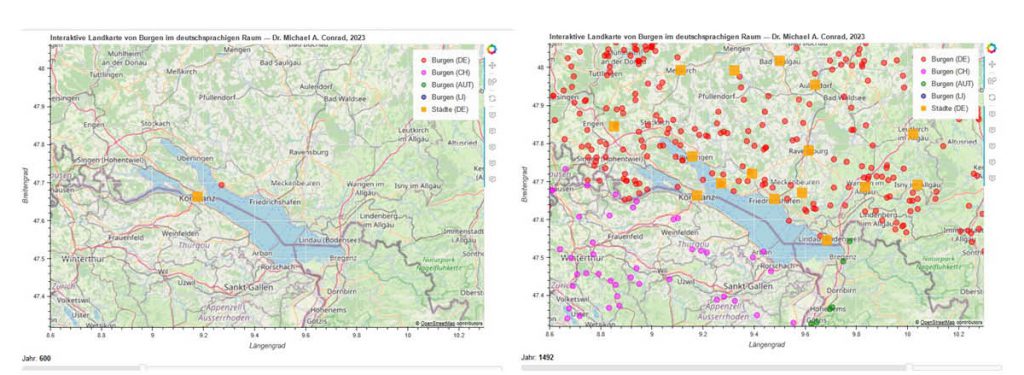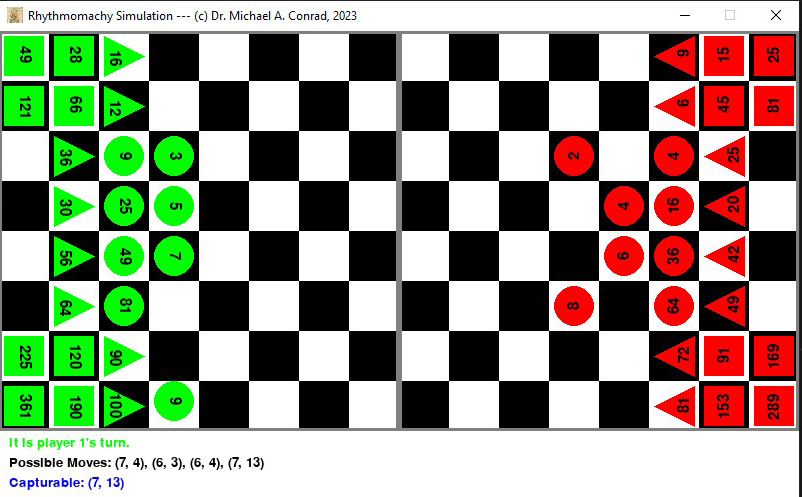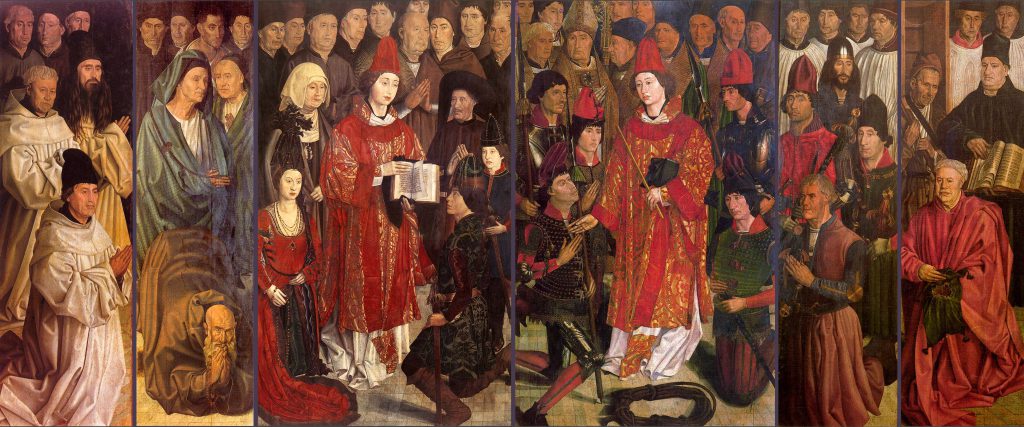Episode 11: Michael Allman Conrad on “Gamified Numbers”
May 26, 2023 in Manuscript Studies, Research Group Speaks (The Series), Uncategorized
The Research Group Speaks
Episode 11
Saturday 8 July 2023 online
12:00–1:30 pm EDT (GMT-4) by Zoom
“Gamified Numbers and Digitalized Castles:
Digital Reconstructions of Medieval Board Games
and Other Forms of Data Visualization
as Methods in the Humanities“
Michael Allman Conrad
[Posted on 5 June 2023, with updates]
For Episode 11 in the online series of The Research Group Speaks, our Associate Michael Allman Conrad will talk about his ongoing work on games, board games, and interrelations between gameplay and numbers.

Left: Rhythmomachy Simulation (Player 1’s turn). Image © 2023 Michael A. Conrad.
Right: Bibliothèque interuniversitaire, Section Médecine, Montpellier, H 366, f. 13v, with rhythmomachy pyramids at the top flanking a lion’s mask. Image via Creative Commons.
Recently, Michael spoke about some aspects of this work for a Session co-sponsored by the Societas Magica and the Research Group on Manuscript Evidence at the 2023 International Congress on Medieval Studies in May. See the Program for our activities there (2023 Congress Program) and the illustrated Abstract for Michael’s paper.
In our co-sponsored Session on “Teaching Astrology and Other Liberal Arts” , Michael’s topic was “Gamified Numbers: Board Games as Educational Instruments for Teaching Astrology and Other Quadrivial Arts”. In the short time-span permitted by a full Session with four individual presentations , he briefly examined the game of rhythmomachy (rhitmomachia or “Battle of Numbers”), an early mathematical board game, and described his project of studying and preparing a computer simulation for its play.
Now we have the opportunity to hear Michael describe this complicated game, its origins, and its intricate relationship with knowledge of Boethian theories on the mathematical arts. That is, its structure is grounded in the understanding of those arts expounded by Anicius Manlius Severinus Boethius (circa 480 – 524 CE) in his influential manual De Institutione arithmetica Libri duo, based upon his loose translation of the treatise on the subject composed in Greek by the Neopythagorean philosopher Nicomachus of Gerasa (circa 60 – circa 120 CE).
More than that, Michael’s explorations of the game and its underlying theories build a bridge to a more general debate on the use of digital methods in the humanities, which he is also exploring in different ongoing data projects of his, some of which he is also going to introduce briefly in the course of his paper. The discussion will start with reflections on his experiences with using these methods, their requirements, benefits, and downsides.
Please register to attend this online event (see below).
Title for Episode 11
“Gamified Numbers and Digitalized Castles:
Digital Reconstructions of Medieval Board Games
and Other Forms of Data Visualization
as Methods in the Humanities“
Michael’s Abstract
To use games and play in medieval education was by no means unusual but a rather common practice. Nicolaus Cusanus (1401–1464) — who in De ludo globi or “The Globe Game” (1463) introduces his own educational, in fact theological, game — once even remarked that every liberal art can be associated with at least one specific game with conceptual similarities, thus hinting at a notion of a double-nature of games constantly oscillating between instruments and pleasurable pastimes. One of the most illustrative and extraordinary examples in this context certainly is rhythmomachy (rhitmomachia or “Battle of Numbers”), an early mathematical board game.
Collapsing mathematical operations and motions of game pieces, rhythmomachy embodies a deep, intrinsic connection between numbers and gameplay that was already known to antiquity, and conveys the cosmological idea of the inseparability of all branches of knowledge within the microcosm of a game. Consequently, the game could be perceived as a microscopic mirror of macrocosmic relations.
Starting with such observations, the talk is going to take the opportunity to introduce the ongoing work of a digital reconstruction of the game, with an examination of the requirements needed, the steep learning curve, and how the humanities might benefit from such endeavors methodologically, though not without addressing problems and downsides. From there, the presentation will branch out to other current data projects, such as an interactive map of medieval castles in time [see the images above] and the use of Optical Character Recognition (OCR) and Natural Language Processing (NLP) for the daily work with texts.
Gained knowledge might not only spark interesting discussions about the use of digital technologies in the humanities (and manuscript studies in particular), but also if and how they could help bridge gaps between the interpretative and quantitative disciplines—in many ways resembling Boethius’s holistic approach that, consequently, might become relevant again today more than ever.

Bibliothèque interuniversitaire, Section Médecine, Montpellier, H 366, f. 13v, with rhythmomachy pyramids at the top flanking a lion’s mask. Image via Creative Commons, via https://portail.biblissima.fr/fr/ark:/43093/mdata268b7df0d12be6fa155f802fd66b4123b9ddd65a.
Michael’s Interactive Map
The Foundation of Cities and Building of Castles in Time
From the Year 600 to 1492. Images © 2023 Michael A. Conrad.

An interactive map showing the foundation of cities and building of castles in German-speaking realms: From the Year 600 to 1492. Image © 2023 Michael A. Conrad.
Interactive Map of Castles in the German-speaking Regions in the Year 1492.
Image © 2023 Michael A. Conrad.
Registration for the Episode
Episode 11 in the online series of “The Research Group Speaks” is planned for Saturday 8 July 2023
, via Zoom, at 1 pm EST (GMT – 5) for about 1 1/2 hours, with discussion and Q&A. You are welcome to join us.
If you wish to attend, please register here:
If you have questions or issues with the registration process, please contact director@manuscriptevidence.org.

Rhythmomachy Simulation (Player 1’s turn). Image © 2023 Michael A. Conrad.
Future Episodes
Future Episodes are planned. See
Suggestion Box
Please leave your Comments or questions here, Contact Us, or visit
- our FaceBook Page
- our Twitter Feed (@rgme_mss)
- our Blog on Manuscript Studies and its Contents List
Donations and contributions, in funds or in kind, are welcome and easy to give. See Contributions and Donations.
We look forward to hearing from you.

Lisbon, Museu Nacional de Arte Antiga: The mid 15th-century Saint Vincent Panels, attributed to Nuno Gonçalves. Image (https://upload.wikimedia.org/wikipedia/commons/3/3a/Nuno_Gon%C3%A7alves._Paineis_de_S%C3%A3o_Vicente_de_Fora.jpg) via Creative Commons.
*****
Continuing Conversations
This is the second Episode in our series wherein “The Research Group Speaks” to focus upon Michael and his work. Episode 8 presented “Falling in Love with a Source”: An Interview with Michael Allman Conrad.
Michael has contributed frequently to RGME events. For example:
- Conrad (2018 Congress)
- Conrad (2019 Congress)
- Conrad (2019 Symposium)
- Conrad (2020>2021 Congress)
- Conrad (2022 Congress)
- Conrad (2023 Congress)
We thank Michael for his continuing contributions to the Research Group.
*****
